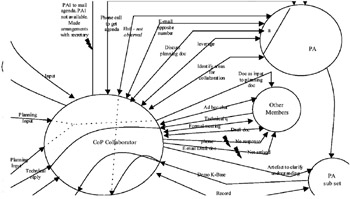APPENDIX 5: EXAMPLE OF CONSOLIDATED FLOW MODEL
|
APPENDIX 5: EXAMPLE OF CONSOLIDATED FLOW MODEL[*]
In Step One, a complete list of responsibilities was generated for each individual. Roles were then created and named. The example below shows how this was done for W.
| W: Manager UKIT | |
|---|---|
| | |
| • | Provide tools, infrastructure, support for distributed international working |
| • | Liaise with other areas in Labs (e.g., Internet telephony) |
| • | versee the three teams in UKIT |
| • | udget responsibilities |
| • | ead team meetings |
| • | dvisory (e.g., meeting with Bea and Stan) |
| • | Liaise with PA/coordinate |
| | |
| Roles: |
|---|
| |
| Manager |
| Oversee the three teams in UKIT |
| Budget responsibilities |
| Lead team meetings |
| Personnel matters Personal evaluations |
| |
| CoP Collaborator |
| Liaise with PA/coordinate |
| Arrange WWIT meetings with PA |
| Look for opportunities for collaboration/leverage |
| Technical |
| Provide tools, infrastructure, support of distributed international |
| Working |
| Collaborator |
| Liaise with other areas in labs |
| Advisory |
When all of the roles and responsibilities had been created for each of the CoP members, they were combined into one consolidated Flow Model.

Figure 1: Consolidated Flow Model—Detail
[*]In these appendices, there are examples of the different models which are used in Contextual Design. Some of the models are very large, therefore the reduced representations shown are only intended to give an overall impression of what the model will look like. Where appropriate a small section of the model has been magnified to give the reader more detail about the type of information which might appear in the model.
|
EAN: 2147483647
Pages: 77